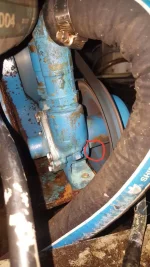madhatter66
Active member
- Joined
- Sep 12, 2013
- Messages
- 85
- Status
- OWNER - I own a Hatteras Yacht
- Hatteras Model
- 34' CONVERTIBLE (1965 - 1969)
Water pump seized up a while back. It was rebuilt using the kit including impeller. Sherwood E35 on 454. Ran last Sunday. 20-30min ride. She ran great. Spent about an hour on anchor (12-15ft of water) we came back in. She started to run hot 15min into the return trip. I noticed no so called gargling (water flow) in the strainer. Did not see any blockage. Shut down and came in on 1 motor. Finally got to look. No blockage in the input/output of the strainer. I took a video shows gargle water flow however there's a slight dribble of water from pump. Is that normal to cool off the bearings? This was a lil after 5min from cold start. The drop of water from the pump every 3 secs.


